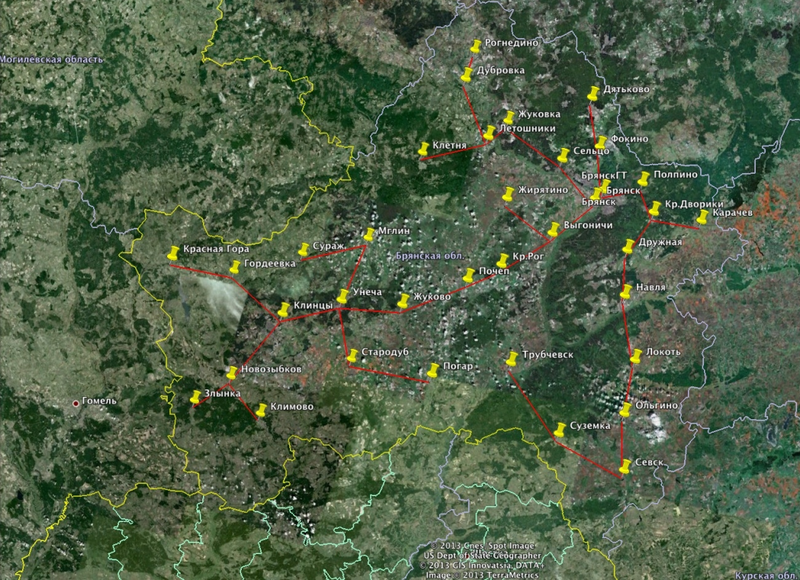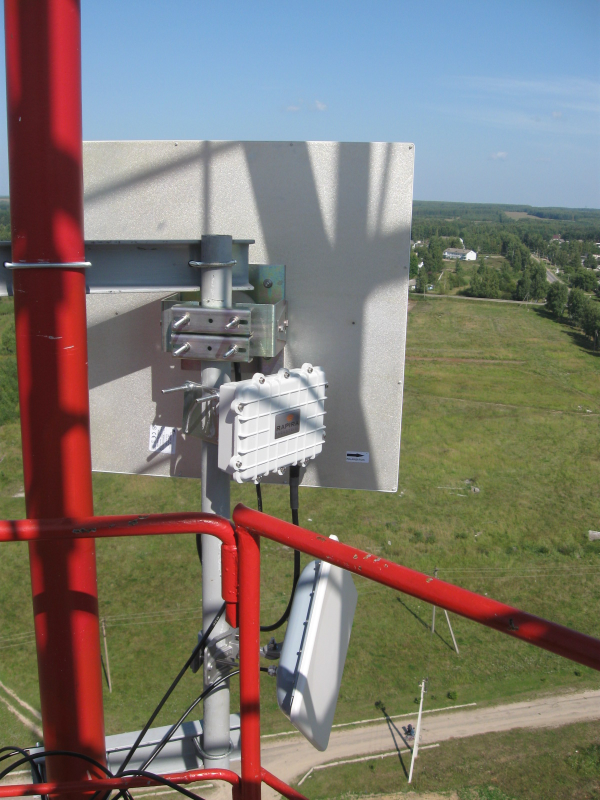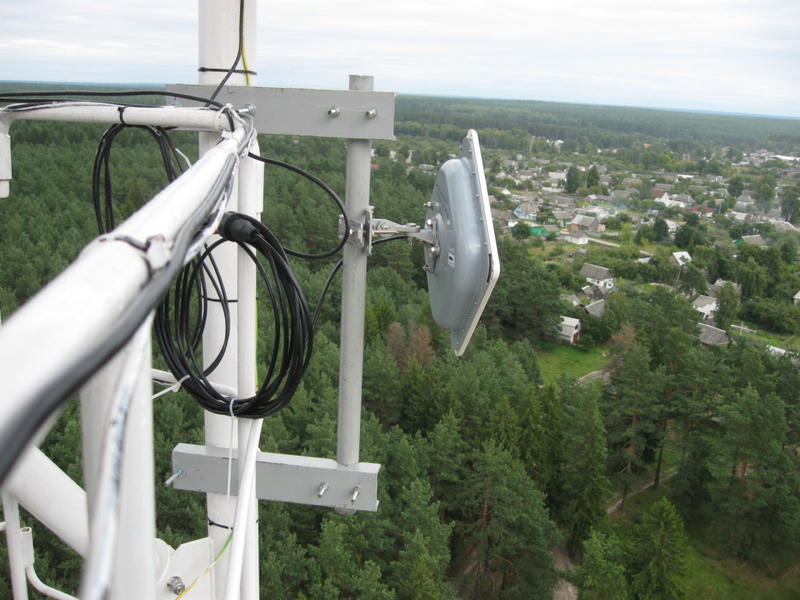And what is happening in Dyatkovo or the all-seeing eye of the governor
Informatization of executive authorities on the example of the Bryansk region using the wireless router NPO Rapier.
Recently, marked by the rapid growth of broadband access and wireless data transmission technologies. Such technology is in demand on the territory of the Russian Federation, since it is not only less susceptible to vandals and other seekers of non-ferrous metal (sadly - but fact), but also has a high network deployment speed, which does not depend so much on the season (unlike the same fiber lines). Although the latter statement is possible and controversial, especially for those who aired on the mast at the end of December, remembering the authorities with a kind word;).
Unlike wired networks, where bandwidth and medium availability are almost constant, in wireless networks these parameters are extremely vulnerable characteristics. The frequency resource in cities is extremely limited and it is required to have channel equipment that allows using it as efficiently as possible.
')
Based on these requirements, you can form the following key hardware requirements:
- effective work with "hidden" nodes
- guaranteed bandwidth for each customer
- independent bandwidth control for each client
- VLAN support
- multiSSID support
- QoS support
- SNMP support
In terms of these requirements, we present another example of a solution based on Rapier equipment for organizing a deployed wireless network covering most of the territory of the Bryansk region.
As part of the informatization project of the Bryansk region, a wireless data network was deployed based on Rapier radio routers. Within the framework of this project, an infrastructure was built, which made it possible to successfully solve the following tasks:
- The provision of information services based on the use of radio access by state / municipal authorities and the population.
- Introduction of promising geo-information services in the interests of innovative development of the region through the use of the capabilities of the global navigation satellite system (GLONASS) and Geoportals
- Information and technological support of medical institutions of the municipalities of the Bryansk region (use of telemedicine services)
- Implementation of the tasks of telecommunication support of distance learning programs
- Implementation of a video conferencing system between regional, municipal and district (27 districts) power structures.
- The project has implemented an internal network for electronic document management using data transmission protection systems based on Continent crypto-gateways.
- A VoIP network is organized for internal communication with access to urban PTS.
The installation of the start-up equipment and its commissioning were carried out by the specialists of the Bryansk-based Computer Technologies company with the participation of NPA Rapier. To implement the project, towers of the Bryansk ORTPTs and the Bryansk branches of MegaFon, MTS and Beeline were used.
The geography of the location of network points is presented below:

General network features:
- The number of main spans - 35.
- The number of base stations - 28
- Number of subscribers - 54
- Network latency - up to 15 ms (at the far points)
- Transfer speed per subscriber - from 10 to 25 Mbps
- Probability of data transmission error - 10 -5
To implement the project, the industrial solution RAPIRA with a cold start system was chosen.
The equipment used in the project is listed below:


Zhukovsky district, pos. Flyers, MegaFon's tower with radio routers mounted on a pipe rack: RS3-AP1-F5060-PTP connected by a feeder to the WA55-30 antenna, below is the base station RS3-AP1-F5060-PTP-T with an integrated antenna.

Client station RS3-CPE-F5060-PTP-T , located on a cell tower in the mountains. Dyatkovo
The specified equipment manufactured by NPO Rapier LLC has the following key functional capabilities:
- Create single and multi-sector access points. The use of solutions with both integrated and external antennas allows flexible configuration of the network infrastructure, if necessary, installing external antennas with different radiation patterns to solve specific problems.
- Sealed aluminum enclosures of devices and reliable lightning protection reduce the risks associated with weather conditions and increase the "survivability" of the network.
- Prioritization and quality of service control mechanisms provide an opportunity to provide high-quality and reliable channels for heterogeneous traffic.
- Temporary division of the band between customers allows you to guarantee quality service for each of them.
- The network monitoring system via SNMP solves the issues of network reliability management.
The functionality of base stations and client equipment includes all the necessary tools to ensure quick setup and continuous network operation without failures.
Let us consider in more detail one of the sections of the network of mountains Village, the topology of this site is presented below:

To simplify the description of the structure of traffic transmitted in the network, we divide traffic into 4 types: video, IP-telephony, intranet, internet.
Video traffic, ip-telephony and intanet are each transmitted via a separate VLAN with the selected service class through the DSCP setting in the IP packet header.
The following table shows the assigned service classes by VLAN.

To ensure quality of service, the following mechanisms are involved:
- polling
- polling band restrictions
- QoS
- VLAN
- bandwidth restrictions on each vlan

The wireless subsystem is based on polling, where each client has its own speed limits:

*) CIR - guaranteed bandwidth
**) MIR - maximum bandwidth
Speed limits are introduced to provide guaranteed bandwidth for video conferencing and VoIP. If the real band is wider, the system automatically distributes the additional band in proportion to the ratio of the MIR indicator for each client.
On each of the clients, the introduction of the following restrictions on each VLAN-y (restriction imposed on the interface)
Note that, on the basis of the polling, we obtained severe speed limits at the client's access level to the base, through the TDM mechanism for allocating a time quantum, the time of communication with the base. Due to it, the problem of the “hidden” node was also solved and the guaranteed bandwidth at the physical level was provided.
Stable network operation depends on the predicted load on the channel from the client. The speed limiting mechanism on the interface made it possible to form a predictable channel load from the client in accordance with the velocity distribution table for VLANs. If there is not enough bandwidth, it is distributed in proportion to this table.
To preserve the quality of service when changing bandwidth when influenced by external factors, stream prioritization is introduced through the QoS queue mechanism and classes of service (DSCP) are assigned for each of the VLANs.
Radio network management is implemented on the basis of SNMP with monitoring of the following parameters:
- node availability
- packet delay to node
- signal level
- number of lost packets on interfaces
Using the integrated monitoring system Nagios allows real-time to get both general information about the state of the system in general, and about a particular network node in particular.
Access to information is available through the web portal, where you can view the current state of the network and set up a monitoring and notification system. Support for encrypted SSH and SSL based tunnels provided a reliable transport for data exchange between radio routers and the monitoring system.
If an exception occurs, the system can notify the operator or administrator via mail, pager, sms-notification or in any other way specified by the user through the system's notification module.
As a result, the necessary technical base was created, providing customers with telephone, electronic document circulation, access to the Internet and allowing to participate in video conferences.
The expanded network allows you to implement the task of transferring the required amount of information and provide an acceptable quality of service for all data streams.
We are grateful to Computer Technologies LLC, in particular, Vladimir Reshetnikov, specialist of the system administration department, for help in preparing the material.
Source: https://habr.com/ru/post/175065/
All Articles